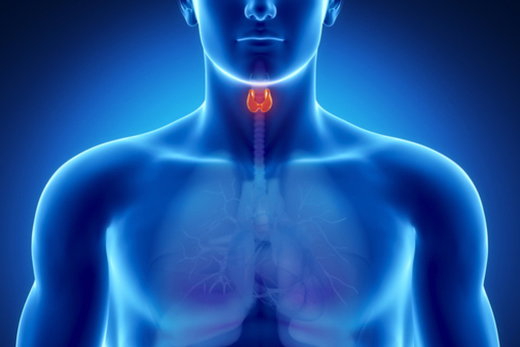Since 1991 the annual number of newly documented cases of thyroid cancer in the United States has skyrocketed from 12,400 to 62,450. It's now the seventh most common type of cancer.
Relatively little attention is paid to the butterfly-shaped thyroid gland that wraps around the throat. Many don't even know what the gland does. But this small organ (and the hormone it produces) is crucial to physical and mental development, especially early in life.
Cancer of the thyroid also gets little attention, perhaps because it is treatable, with long-term survival rates more than 90 percent. Still, the obvious question is what is causing this epidemic, and what can be done to address it?
Recently, there has been a debate in medical journals, with several authors claiming that the increase in thyroid cancer is the result of doctors doing a better job of detecting the disease at an earlier stage. A team of Italian researchers who published a paper last January split the difference, citing increased rates and better diagnosis. But as rates of all stages of thyroid cancer are soaring, better detection is probably a small factor.
So, what are the causes?
The Mayo Clinic describes a higher frequency of occurrence of thyroid cancer in women (not a telling clue, unless more is known about what predisposes women to the condition). It mentions inherited genetic syndromes that increase risk, although the true cause of these syndromes aren't known. And Mayo links thyroid cancer to exposure to radiation. The latter is perhaps the only "cause" for which there is a public policy solution.
In the atomic age, radioactive iodine (chiefly Iodine-131) has proliferated, from atom bomb explosions and now from nuclear power reactors.
The thyroid gland requires iodine, a naturally occurring chemical. But it doesn't distinguish between radioactive Iodine 131 and naturally occurring iodine. Iodine 131 enters the human body via the food we eat, the water we drink and the air we breathe, damaging and killing cells, a process that can lead to cancer and other diseases.
The current debate in medical journals, or lack of one, ignores the obvious. Although the specific process that causes thyroid cancer isn't known, many scholarly studies have already linked exposure to radioactive iodine to increased risk. Studies of Japanese survivors of the atomic bombs the United States dropped on Hiroshima and Nagasaki found the cancer with the greatest increase was thyroid cancer.
Today, one of the main sources of human exposure to radioactive iodine is nuclear power reactors. Not only from accidents like the ones at Chernobyl and Fukushima, but from the routine operation of reactors. To create electricity, these plants use the same process to split uranium atoms that is used in atomic bombs. In that process, waste products, including I-131, are produced in large amounts and must be contained to prevent exposure to workers and local residents. Some of this waste inevitably leaks from reactors and finds its way into plants and the bodies of humans and other animals.
- A U.S. government survey of cancer rates among residents of the Marshall Islands, who were exposed to U.S. bomb testing in the 1950s, found thyroid cancer outpaced all others.
- A 1999 federal study estimated that exposure to I-131 from bomb testing in Nevada caused as many as 212,000 Americans to develop thyroid cancer.
- A 2009 book on the Chernobyl nuclear plant disaster found soaring levels of local thyroid cancer rates after the meltdown, especially among children, and workers called "liquidators," who cleaned up the burning plant.
- More recently, studies have documented thyroid cancer rates in children near Fukushima, Japan, site of the 2011 meltdown, to be 20 to 50 times above the expected rate.
The highest rates of thyroid cancer in the United States, according to federal statistics, are found in New Jersey, Pennsylvania, and New York, states with the densest concentration of reactors in the nation. In a study conducted in 2009, one of this article's authors (Janette Sherman) found the highest rates of thyroid cancer occurring within 90-mile radiuses of the 16 nuclear power plants (13 still operating) in those states.
Declaring "we don't know why" and continuing to diagnose and treat the growing number of Americans suffering from thyroid disease is not sufficient. Causes must be identified, preventive strategies must be implemented, and ultimately policy makers will have to take a serious look at closing the 99 nuclear reactors currently operating in the United States.
About the authors
Joseph Mangano, MPH MBA, is the author of Mad Science (pub. 2012) as well and many articles on the effects of nuclear power. He is an epidemiologist, and Executive Director of the Radiation and Public Health Project and can be reached at: (www.radiation.org).
Janette D. Sherman, M. D. is the author of Life's Delicate Balance: Causes and Prevention of Breast Cancer and Chemical Exposure and Disease, and is a specialist in internal medicine and toxicology. She edited the book Chernobyl: Consequences of the Catastrophe for People and Nature, written by A. V. Yablokov, V. B., Nesterenko and A. V. Nesterenko, published by the New York Academy of Sciences in 2009. Her primary interest is the prevention of illness through public education. She can be reached at: toxdoc.js@verizon.netand www.janettesherman.com




Comment: Living in a toxic world: Iodine to the rescue